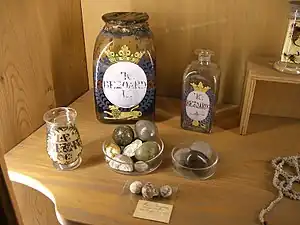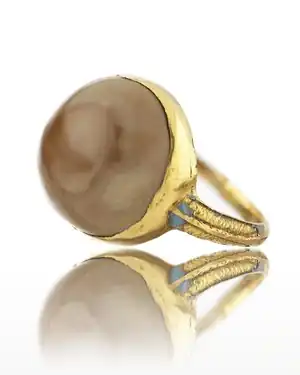Bezoar
| Bezoar | |
|---|---|
 | |
| Bezoar stones were seen as valuable commodities, sometimes with magical healing properties, as in the early modern English case Chandelor v Lopus.[1] | |
| Pronunciation |
|
| Specialty | Emergency medicine |
A bezoar is a mass often found trapped in the gastrointestinal system,[2] though it can occur in other locations.[3][4] A pseudobezoar is an indigestible object introduced intentionally into the digestive system.[5]
There are several varieties of bezoar, some of which have inorganic constituents and others organic. The term has both a modern (medical, scientific) and traditional usage.
Types
By content
- Food boluses (or boli; singular bolus) have the archaic and positive meaning of bezoar, and are composed of loose aggregates of food items such as seeds, fruit pith, or pits, as well as other types of items such as shellac, bubble gum, soil, and concretions of some medications.
- Lactobezoars are a specific type of food bezoar comprising inspissated milk. It is most commonly seen in premature infants receiving formula foods.
- Pharmacobezoars (or medication bezoars) are mostly tablets or semiliquid masses of drugs, normally found following overdose of sustained-release medications.[6]
- Phytobezoars are composed of indigestible plant material (e.g., cellulose), and are frequently reported in patients with impaired digestion and decreased gastric motility.
- Diospyrobezoar is a type of phytobezoar formed from unripe persimmons.[7] Coca-Cola has been used to treat them.[8][9][10]
- Trichobezoar is a bezoar formed from hair[11] – an extreme form of hairball. Humans who frequently consume hair sometimes require these to be removed. In cases of Rapunzel syndrome, surgery may be required.
By location
- A bezoar in the esophagus is common in young children and in horses; in horses, it is known as choke.
- A bezoar in the large intestine is known as a fecalith.
- A bezoar in the trachea is called a tracheobezoar.
Cause
Esophageal bezoars discovered in nasogastrically fed patients on mechanical ventilation and sedation are reported to be due to precipitation of certain food types rich in casein, which are precipitated with gastric acid reflux to form esophageal bezoars. Bezoars can also be caused by gastroparesis due to the slowing of gastric emptying, which allows food to form a bolus.[12]
History
The word bezoar is derived from the Persian pād-zahr (پادزهر), literally "antidote".[13] The myth of the bezoar as an antidote was introduced to Europe from the Middle East in the 11th century and remained popular until the 18th century.[14] It was believed to have the power of a universal antidote, would work against any poison, and that a drinking glass which contained a bezoar could neutralize any poison poured into it.

Ox bezoars are used in Chinese herbology, also known as niu-huang (牛黃) or calculus bovis. They are gallstones or gallstone substitutes created from ox or cattle bile. In some products, they claim to remove toxins from the body.
The Andalusian physician Ibn Zuhr (d. 1161), known in the West as Avenzoar, is thought to have made the earliest description of bezoar stones as medicinal items.[15] Extensive reference to bezoars also appears in the Picatrix.
In 1567, French surgeon Ambroise Paré did not believe that it was possible for the bezoar to cure the effects of any poison, and described an experiment to test the properties of the stone. A cook in the King's court was sentenced to death, and chose to be poisoned. Paré administered the bezoar stone to the cook, but it had no effect, and the cook died in agony seven hours after taking the poison, proving that contrary to popular belief, the bezoar could not cure all poisons.[16]
Modern examinations of the properties of bezoars by Gustaf Arrhenius and Andrew A. Benson of the Scripps Institution of Oceanography show that when bezoars are immersed in an arsenic-laced solution, they can remove the poison. The toxic compounds in arsenic are arsenate and arsenite; each is acted upon differently by the bezoars: arsenate is removed by being exchanged for phosphate in brushite found in the stones, while arsenite is bound to sulfur compounds in the protein of degraded hair, which is a key component in bezoars.[17]
A famous case in the common law of England (Chandelor v Lopus, 79 Eng Rep. 3, Cro. Jac. 4, Eng. Ct. Exch. 1603) announced the rule of caveat emptor ("let the buyer beware") if the goods they purchased are not in fact genuine and effective. The case concerned a purchaser who sued for the return of the purchase price of an allegedly fraudulent bezoar.
Bezoars were important objects in cabinets of curiosity and natural history collections, mainly for their use in early modern pharmacy and the study of animal health.[18][19]
The Merck Manual of Diagnosis and Therapy notes that consumption of unripened persimmons has been identified as the main cause of epidemics of intestinal bezoars, and that up to 90% of bezoars that occur from excessive consumption require surgery for removal.[20]
A 2013 review of three databases identified 24 publications presenting 46 patients treated with Coca-Cola for phytobezoars. The cola was administered in doses of 500 mL to up to 3000 mL over 24 hours, orally or by gastric lavage. A total of 91.3% of patients had complete resolution after treatment with Coca-Cola: 50% after a single treatment, with others requiring the cola plus endoscopic removal. Doctors resorted to surgical removal in four cases.[21]
See also
- Bezoardicum
- Enterolith
- Fecalith
- Gastrolith
- Gorochana
- Regurgitalith
- Snake-stones
- Toadstone
- List of English words of Persian origin
- Coca-Cola treatment of phytobezoars
- Goa stone
References
Notes
- ↑ (1603) 79 ER 3
- ↑ "bezoar" at Dorland's Medical Dictionary
- ↑ Bala M, Appelbaum L, Almogy G (November 2008). "Unexpected cause of large bowel obstruction: colonic bezoar". Isr. Med. Assoc. J. 10 (11): 829–30. PMID 19070299.
- ↑ Pitiakoudis M, Tsaroucha A, Mimidis K, et al. (June 2003). "Esophageal and small bowel obstruction by occupational bezoar: report of a case". BMC Gastroenterol. 3 (1): 13. doi:10.1186/1471-230X-3-13. PMC 165420. PMID 12795814.
- ↑ Mintchev MP, Deneva MG, Aminkov BI, Fattouche M, Yadid-Pecht O, Bray RC (1 February 2010). "Pilot study of temporary controllable gastric pseudobezoars for dynamic non-invasive gastric volume reduction". Physiological Measurement. 31 (2): 131–44. Bibcode:2010PhyM...31..131M. doi:10.1088/0967-3334/31/2/001. PMID 20009188.
- ↑ Buckley NA, Dawson AH, Reith DA (January 1995). "Controlled release drugs in overdose. Clinical considerations". Drug Safety. 12 (1): 73–84. doi:10.2165/00002018-199512010-00006. PMID 7741985. S2CID 72704953.
- ↑ Kishan, Asn; Kadli, NK (2001). "Bezoars". Bombay Hospital Journal. Archived from the original on 2008-08-28. Retrieved 2008-10-31.
- ↑ Chung YW, Han DS, Park YK, et al. (July 2006). "Huge gastric diospyrobezoars successfully treated by oral intake and endoscopic injection of Coca-Cola". Dig Liver Dis. 38 (7): 515–7. doi:10.1016/j.dld.2005.10.024. PMID 16330268.
- ↑ Ha SS, Lee HS, Jung MK, et al. (December 2007). "Acute Intestinal Obstruction Caused by a Persimmon Phytobezoar after Dissolution Therapy with Coca-Cola". Korean Journal of Internal Medicine. 22 (4): 300–3. doi:10.3904/kjim.2007.22.4.300. PMC 2687663. PMID 18309693. Archived from the original on 2011-07-22. Retrieved 2008-12-19.
- ↑ Hayashi, Kazuki; Ohara, Hirotaka; Naitoh, Itaru; Okumura, Fumihiro; Andoh, Tomoaki; Itoh, Takafumi; Nakazawa, Takahiro; Joh, Takashi (November 12, 2008). "Persimmon bezoar successfully treated by oral intake of Coca-Cola: a case report". Cases Journal. London, England, U.K.: BioMed Central (published December 11, 2008). 1 (1): 385. doi:10.1186/1757-1626-1-385. ISSN 1757-1626. OCLC 234326274. PMC 2627813. PMID 19077219.
Referring to past reports [1-9], the period from the administration of Coca-Cola until the disappearance of the bezoars was a minimum of 1 day and a maximum of 2 months.
- ↑ Malhotra A, Jones L, Drugas G (November 2008). "Simultaneous gastric and small intestinal trichobezoars". Pediatr Emerg Care. 24 (11): 774–6. doi:10.1097/PEC.0b013e31818c2891. PMID 19018222.
- ↑ "Gastroparesis". Johns Hopkins Medicine. Johns Hopkins University. Retrieved May 26, 2021.
- ↑ Harper, Douglas. "bezoar". Online Etymology Dictionary.
- ↑ Eng, Katharine; Kay, Marsha (November 2012). "Gastrointestinal Bezoars: History and Current Treatment Paradigms". Gastroenterology & Hepatology. 8 (11): 776–778. ISSN 1554-7914. PMC 3966178. PMID 24672418.
- ↑ Byrne, Joseph P. (2012-01-31). Encyclopedia of the Black Death. ABC-CLIO. p. 33. ISBN 978-1598842531.
- ↑ Stephen Paget (1897). Ambroise Paré and His Times, 1510–1590. G.P. Putnam's Sons. pp. 186–187.
- ↑ "Bezoar Stones". Archived from the original on 2013-01-16. Retrieved 2012-11-30.
- ↑ Heintzman, Kit (2018). "A cabinet of the ordinary: domesticating veterinary education, 1766–1799". The British Journal for the History of Science. 51 (2): 239–260. doi:10.1017/S0007087418000274. PMID 29665887.
- ↑ Borschberg, Peter (2010). "The Euro-Asian trade in bezoar stones (approx. 1500 to 1700)". In North, Michael (ed.). Artistic and Cultural Exchanges between Europe and Asia, 1400-1900. Burlington: Ashgate.
- ↑ Merck Manual, Rahway, New Jersey, Sixteenth Edition, Gastrointestinal Disorders, Section 52, p. 780
- ↑ Ladas SD, Kamberoglou D, Karamanolis G, Vlachogiannakos J, Zouboulis-Vafiadis I (2013). "Systematic review: Coca-Cola can effectively dissolve gastric phytobezoars as a first-line treatment". Alimentary Pharmacology & Therapeutics. 37 (2): 169–173. doi:10.1111/apt.12141. PMID 23252775.
Bibliography
- Barry Levine. 1999. Principles of Forensic Toxicology. Amer. Assoc. for Clinical Chemistry. ISBN 1-890883-87-5.
- Martín-Gil FJ, Blanco-Ávarez JI, Barrio-Arredondo MT, Ramos-Sanchez MC, Martin-Gil J. Jejunal bezoar caused by a piece of apple peel – Presse Med, 1995 Feb. 11; 24(6):326.
- The Poison Sleuths: Arsenic – The King of Poisons. Retrieved March 10, 2007. (This webpage is a reprint by the author of an article originally published in the 1997 issue of Science Reporter, published by the National Institute of Science Communication (CSIR) in India.) at archive.today (archived December 5, 2012)
- This article incorporates text from a publication now in the public domain: Chambers, Ephraim (ed.). "Bezoar". Cyclopædia, or an Universal Dictionary of Arts and Sciences. James and John Knapton, et al.
Further reading
- Borschberg, Peter, "The Euro-Asian Trade in Bezoar Stones (approx. 1500–1700)", Artistic and Cultural Exchanges between Europe and Asia, 1400–1900: Rethinking Markets, Workshops and Collections, ed. Thomas DaCosta Kaufmann and Michael North, Aldershot: Ashgate, 2010, pp. 29–43. https://www.academia.edu/4311591
- Borschberg, Peter, "The Trade, Forgery and Medicinal Use of Porcupine Bezoars in the Early Modern Period (c.1500–1750)", ed. Carla Alferes Pinto, Oriente, vol. 14, Lisbon: Fundação Oriente, 2006.
External links